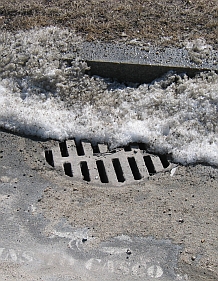Causal Analysis of Biological Impairment In Long Creek, A Sandy-Bottomed Stream In Coastal Southern Maine (Final Report)
Notice
EPA annnounces the release of the Causal Analysis of Biological Impairment in Long Creek: A Sandy-Bottomed Stream in Coastal Southern Maine final document on December 13, 2007.Abstract
This assessment presents results from a complex causal assessment of a biologically impaired, urbanized coastal watershed located primarily in South Portland, Maine, USA - the Long Creek watershed. This case study serves as an example implementation of U.S. Environmental Protection Agency Stressor Identification (SI) guidance (https://www.epa.gov/caddis/).
 The primary goals of the Long Creek case study include: 1) to serve as an example United States Environmental Protection Agency Stressor Identification (SI) case study, whereby the report may help future assessors understand the SI process for other biologically impaired ecosystems, and may help the broader scientific community better understand urban-related stressor interactions, and 2) to provide useful information for the improvement of the Long Creek watershed; this is especially timely, as stakeholders are currently considering options for promoting ecological recovery of the watershed.
The primary goals of the Long Creek case study include: 1) to serve as an example United States Environmental Protection Agency Stressor Identification (SI) case study, whereby the report may help future assessors understand the SI process for other biologically impaired ecosystems, and may help the broader scientific community better understand urban-related stressor interactions, and 2) to provide useful information for the improvement of the Long Creek watershed; this is especially timely, as stakeholders are currently considering options for promoting ecological recovery of the watershed.
 The primary goals of the Long Creek case study include: 1) to serve as an example United States Environmental Protection Agency Stressor Identification (SI) case study, whereby the report may help future assessors understand the SI process for other biologically impaired ecosystems, and may help the broader scientific community better understand urban-related stressor interactions, and 2) to provide useful information for the improvement of the Long Creek watershed; this is especially timely, as stakeholders are currently considering options for promoting ecological recovery of the watershed.
The primary goals of the Long Creek case study include: 1) to serve as an example United States Environmental Protection Agency Stressor Identification (SI) case study, whereby the report may help future assessors understand the SI process for other biologically impaired ecosystems, and may help the broader scientific community better understand urban-related stressor interactions, and 2) to provide useful information for the improvement of the Long Creek watershed; this is especially timely, as stakeholders are currently considering options for promoting ecological recovery of the watershed.
Impact/Purpose
This assessment presents results from a complex causal assessment of a biologically impaired, urbanized coastal watershed located primarily in South Portland, Maine, USA—the Long Creek watershed.
Status
This is the Final document.
Citation
U.S. EPA. Causal Analysis of Biological Impairment In Long Creek, A Sandy-Bottomed Stream In Coastal Southern Maine (Final Report). U.S. Environmental Protection Agency, Washington, DC, EPA/600/R-06/065F, 2008.
History/Chronology
| Date | Description |
|---|---|
| Mar 2006 | EPA sends out the draft document for EPA internal review. |
| Sep 2006 | EPA releases the draft document for an External Peer Review. |
| Dec 2007 | EPA publishes the final document to the NCEA Web site. |
This document has been reviewed in accordance with U.S. Environmental Protection Agency policy and approved for publication. Mention of trade names or commercial products does not constitute endorsement or recommendation for use.
